One of the great things about growing Lomandra longifolia is that it’s perfectly at home almost anywhere in the garden. This grass can be used in many different ways – grow in a pot, create a garden border, or go for a generous planting to fill in parts of a wandering garden landscape.
Spiny head mat rush as you may have heard it called is a real toughie but beautiful at the same time. In our how to grow and care guide, we’ll introduce you to and give you more info about this lovely grass.
There is a section on the different varieties, propagation techniques, and also advice on how to care for your grass. Learn about the pests and diseases to look out for and we’ll also share some frequently asked questions.
More...

Family: | Asparagaceae |
|---|---|
Genus: | Lomandra |
Species: | L. longifolia |
Common Names: | Spiny head mat rush, basket grass |
Location: | Indoor or outdoor |
Type: | Grass |
Growth: | Up to 1 metre tall, 1.2 cm wide |
Sun requirements: | Full sun or partial shade |
Foliage Colour: | Dependent on variety |
Flower Colour: | Dependent on variety |
Flowering: | Late winter/early spring |
Fruit: | Brown pods |
Maintenance level: | Low |
Poisonous for pets: | No |
Introducing Lomandra longifolia
Lomandra longifolia is native to Australia – you just wouldn’t find it in the west or northern territory. The more common name you may have heard is spiny head mat rush or basket grass.
The grass can grow in many different conditions – it can thrive in sandy soil, swamps and other damp landscapes, on cliffs, and also in forests.
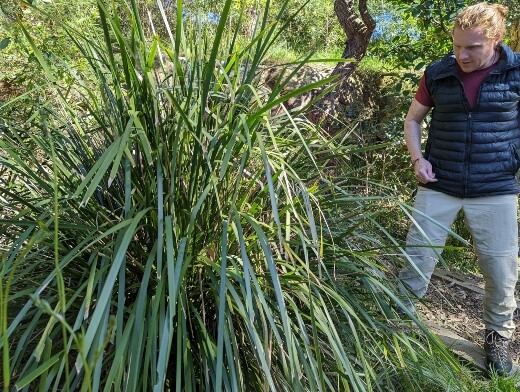
Nathan Schwartz of Aussie Green Thumb standing beside a Lomandra longifolia
Spiny Head Mat Rush Plant Features
As far as grasses go, the spiny head mat rush kind is certainly good looking with shiny green leaves and are coloured with yellow or orange and sometimes brown markings. The flowers it produces look a bit like straw and are spiky.
They have a good scent too. The nectar of the flowers attracts beetles that help with pollination and you’ll usually see flowers appearing at the end of winter time or the beginning of spring. They are a yellowish colour.
You can grow your Lomandra longifolia indoors in a pot if you like or outdoors. The grass likes moist soil but it can handle drought thanks to a great root system. It can grow in a variety of lighting conditions, and equally, a range of soils that are anything from sand to clay.
Lomandra longifolia also don’t need a specific pH. As you would have probably realised by now, this is a very easy plant to maintain. If you want to propagate Lomandra longifolia, you can do this by using seed or by dividing an existing plant.
Our reason for calling this plant a toughie, is that it’s incredibly drought tolerant but also handles flooding well. Spiny head mat rush can survive cold temperatures but doesn’t like a wet winter or cold summer.
The Aboriginal people have long appreciated Lomandra longifolia. They use the leaves to make nets and baskets and also eat it as a food source.
Lomandra longifolia Varieties
Lomandra ‘Katrinus Deluxe’This is a smaller growing variety, ideal for coastal regions and windy areas. It has gloriously green foliage and striking yellow flowers which bloom throughout spring and summer. | 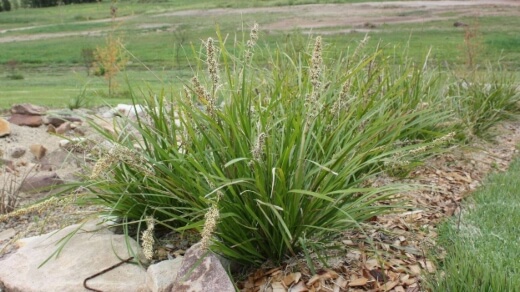 Source: Alpine Nurseries |
Lomandra ‘Nyalla’The Nyalla variety is by far the toughest of all lomandra plants. It is incredibly adaptable and perfect for hot summer gardens. This variety has blue-green foliage and yellow flowers. |  Source: Plantmark |
Lomandra ‘Tanika’This variety also has blue-green foliage and is one of the most popular grown varieties. It’s perfect for landscaped foliage, with very graceful arching foliage. | 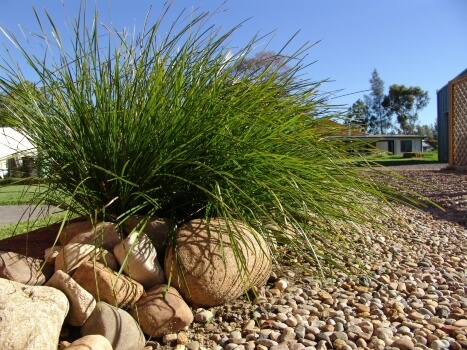 Source: Gardening with Angus |
Lomandra ‘Great White’The great white variety is a dense, variegated cultivar with particularly large flowers. It’s very tolerant of coastal conditions and offers a great way to add some contrast to the garden. |  Source: Mansfield’s Propagation Nursery |
Lomandra ‘Katrinus Deluxe’

Source: Alpine Nurseries
This is a smaller growing variety, ideal for coastal regions and windy areas. It has gloriously green foliage and striking yellow flowers which bloom throughout spring and summer.


Get Your Free Guide:
Master Growing Australian Natives eBook
A Must Have Complete Guide for Every Australian Garden
Get Your Free Guide:
Master Growing Australian Natives eBook
A Must Have Complete Guide for Every Australian Garden
Lomandra ‘Nyalla’

Source: Plantmark
The Nyalla variety is by far the toughest of all lomandra plants. It is incredibly adaptable and perfect for hot summer gardens. This variety has blue-green foliage and yellow flowers.
Lomandra ‘Tanika’

Source: Gardening with Angus
This variety also has blue-green foliage and is one of the most popular grown varieties. It’s perfect for landscaped foliage, with very graceful arching foliage.
Lomandra ‘Great White’

Source: Mansfield’s Propagation Nursery
The great white variety is a dense, variegated cultivar with particularly large flowers. It’s very tolerant of coastal conditions and offers a great way to add some contrast to the garden.
How to Grow Lomandra longifolia
Lomandra longifolia can germinate quite quickly and easily from seed. You’ll need to wait until the fruit ages and becomes brown. You will then know that it’s ready to sow the seed in a potting mix and water well. In about 6 weeks you’ll have your own seedling.

Propagating Lomandra longifolia
The easiest way to propagate spiny head mat rush is to dig up an existing plant and then divide it up. If you’re going this route, you need to ensure there are enough roots to work with otherwise the plant won’t survive.
You can replant your divided section in autumn, winter or spring. For more detailed instructions on each of the propagation methods, have a look at the sections below.
Propagating Spiny Gead Mat Rush from Seed
True to a low maintenance nature, the Lomandra longifolia seeds don’t need to be pretreated before you plant them and await germination. The time between December and February is best for harvesting the seed you need from a female plant after it has been fertilised by a male plant and bees.
When the spiny head mat rush grass is in the flowering process, you can remove the seed head. It might be confusing as the seed head looks more like fruit. You can pop the seed head you have cut into a paper bag and keep it somewhere warm.
Eventually the fruit opens and the seed will be contained in the bag. Prepare a seed raising mix and then scatter the seed over this mixture. The soil should remain moist constantly and you should see germination in about 6 weeks’ time.
Lomandra longifolia Propagation by Division
If you want to go the super easy route you can divide a mature plant. Start by digging up an existing clump of Lomandra longifolia. It’s best to use pruning shears or a sharp knife when you divide up the root ball. (Don't miss our review of the best pruning shears for 2024.)
Cut back any leaves that look long and strappy, and then you can plant the new divided plant back in the soil. It really is that simple!
Caring for Spiny Head Mat Rush
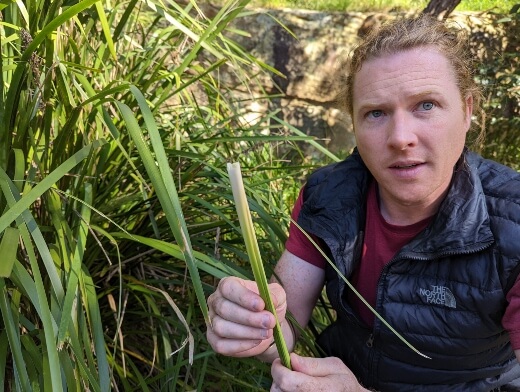
Nathan Schwartz of Aussie Green Thumb holding a Lomandra longifolia leaf
Sunlight Needs
Your Lomandra longifolia grass can happily live in full sun or partially shady spots. You might notice, that depending how much sunlight the grass gets, the colour of the leaves might be different. The colour of the leaves has nothing to do with plant health though.
What Soil to Use
The Lomandra longifolia can grow in a range of different soils – anything from sand to clay is perfectly acceptable, as long as the soil is moist.
Watering Schedule
Looking for a water saving element to your garden? The spiny head mat rush becomes drought tolerant once the grass is mature. It is however recommended to give your Lomandra longifolia water now and then.
In the case of a freshly planted grass, it will need water to settle and to kick start new roots. If you’re experiencing weather that is hot or dry in the seasons after you’ve planted your Lomandra longifolia, aim to water once a week.
Fertilising Spiny Head Mat Rush
Lomandra longifolia as a young and new plant, can do with some feeding every 4 weeks for the spring, summer and autumn seasons. Once your spiny head mat rush has then established itself, you can then just fertilise in the springtime using an organic fertiliser or even compost.
Pruning Lomandra longifolia
It’s possible that the leaves of your Lomandra longifolia could suffer some wind damage or even just start to look a bit aged. If this is the case, you can prune back your grass around 20cm during winter or even at the start of spring to revive it.
Over and above this, a good pruning every 2 years to a minimum length of 15cm is good to keep growth on track and to keep a good shape for your plant. Once you have done your pruning, we recommend adding a slow-release fertiliser.
Some of the varieties of Lomandra longifolia get dead leaf build up and can start to look a bit ugly. If this is happening, you can prune the grass all the way back to ground level. Any dead flowers can be cut off.
We love honest and in-depth reviews. If you get excited about power tools and shovels, garden hoses and planters, have a look at our gardening tools and products guide here.
Pests and Diseases that Affect Lomandra longifolia
Lomandra longifolia luckily doesn’t deal much with pests or diseases. This species is loved by some butterflies who might use the leaves to lay eggs and as a snack.
If you see some tiny caterpillars hanging out on your spiny head mat rush, this might be the case but they actually don’t harm the leaves. If anything, you’ll have lots of pretty butterflies hanging about.
Phytophthora
As with many native plants, you might end up dealing with Phytophthora which causes root rot and can in fact kill your plant. Symptoms are yellow leaves or if you notice that your plant is starting to die. In the case of a tree, you could change the soil around the tree and down to the roots and allow the root system to dry out.
In the case of a grass like Lomandra longifolia, and other smaller plants, you’re aiming for prevention rather than cure. This is why well-draining soil and conditions are important so the roots don’t sit in water and stay mostly dry.
What makes Phytophthora so problematic, is that it only takes a few hours of standing water for the fungus to germinate. It is unfortunate that in some smaller plants, phytophthora might already be killing off your plant and the disease too far gone by the time you realise what is happening.
If you’re looking to empower yourself with more knowledge around pests and diseases, our guides focus on a range of garden ailments such as spider mites, aphids, and flies. We even focus on the most natural options for pest control in your garden.Lomandra longifolia Frequently Asked Questions
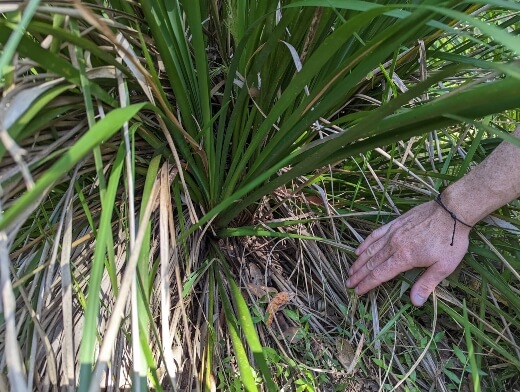
What does the name Lomandra longifolia mean?
Lomandra comes from the Greek word Loma which means edge or border, and the word Aner which means man or male. Longifolia comes from the Latin word Longi which means long, and the word Folia which is Latin for leaf.
What is Lomandra longifolia used for?
The spiny head mat rush grass is incredibly useful. The Wurundjeri people used it to weave baskets, but also to make traps and nets for hunting. Lomandra longifolia can be eaten and the seeds are actually quite high in protein.
The seeds have been used to make bread mix, and the leaves have been eaten as vegetables. The Aboriginal people have used the roots as a treatment for stings and bites.
Need some more gardening advice and inspiration? Have a look at our newsletter for top tips, and all things gardening.
Have Fun Growing Lomandra longifolia Indoors and Outdoors
The leaves of the Lomandra longifolia are seriously good looking – they are green, smell good, and are complemented by pretty flowers. This grass will certainly make a statement in your garden, or even in your home if you choose to grow it indoors.
I love how versatile the spiny head mat rush is – you can grow it next to your pool, in your garden along the coast, somewhere with the worst soil, or even a rocky patch. Lomandra longifolia has earned itself a bit of a reputation as being the plant or grass that will grow where nothing else will. Just don’t overwater it.
If you’re looking for an evergreen plant that is glossy, go with the Lomandra longifolia. I also really appreciate how low maintenance the plant is. The spiny head mat rush has a lovely height at around 1 metre, and give it some slow release fertiliser, and regular water, and you’re set. I am happy to give Lomandra longifolia a green thumbs up!
Published on November 13, 2022 by Nathan Schwartz
Last Updated on January 27, 2025




